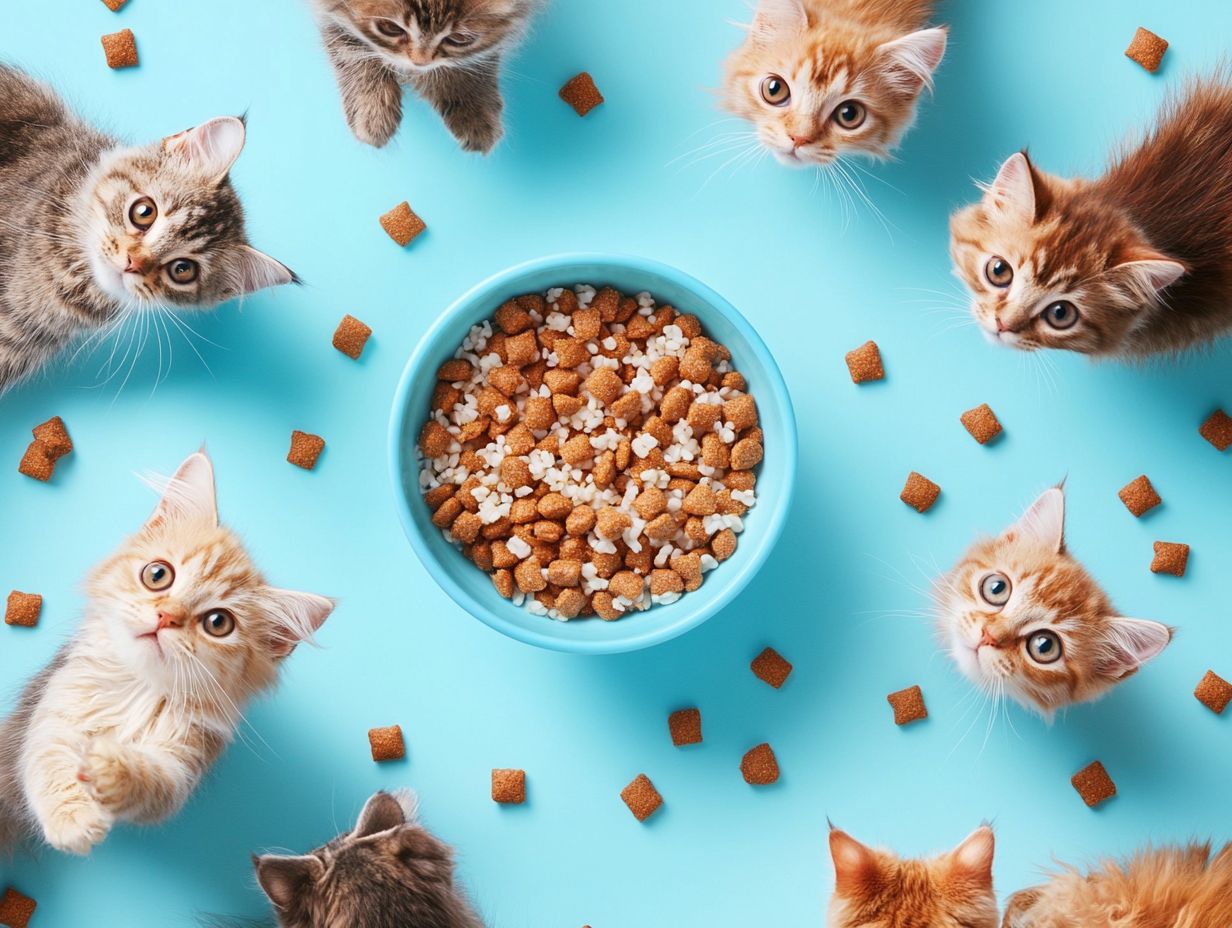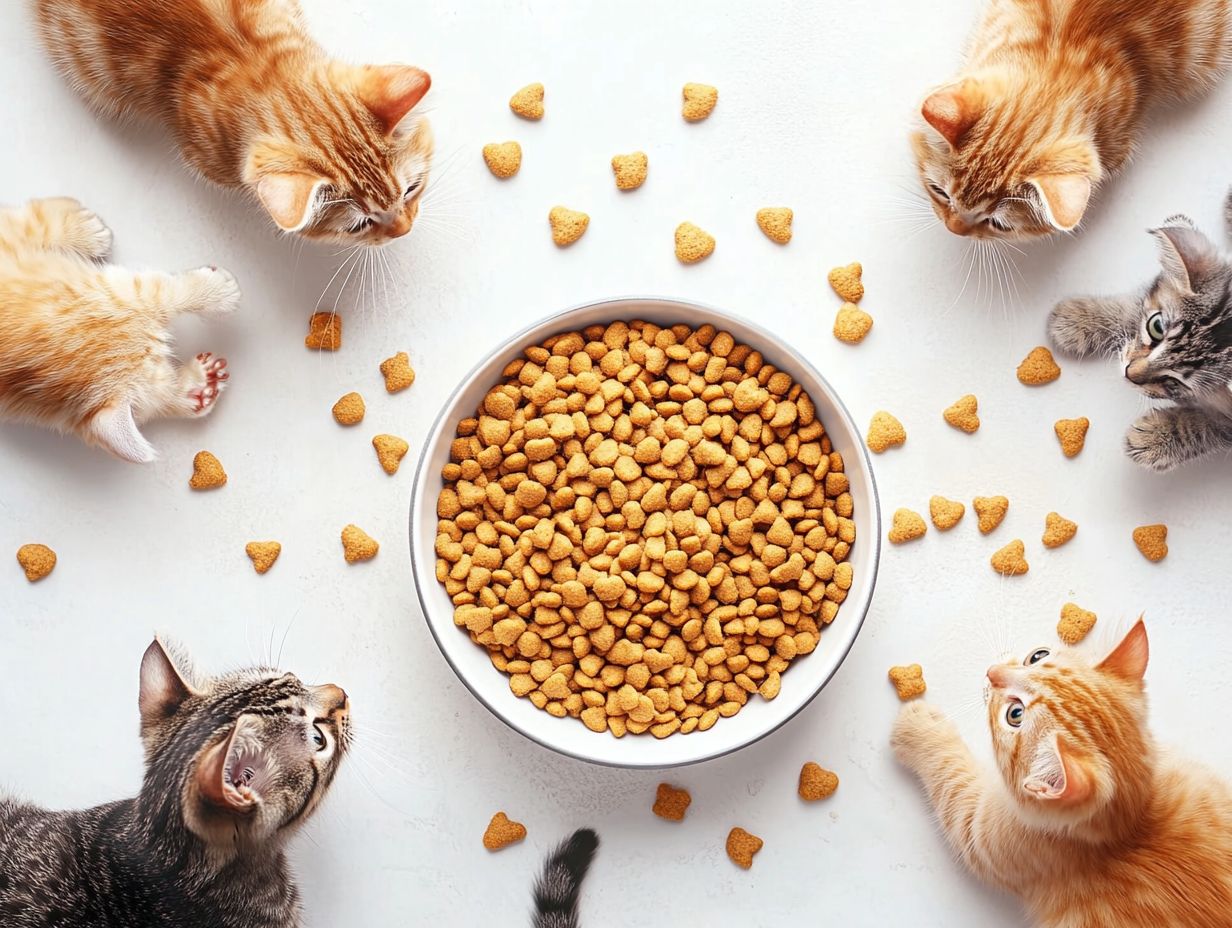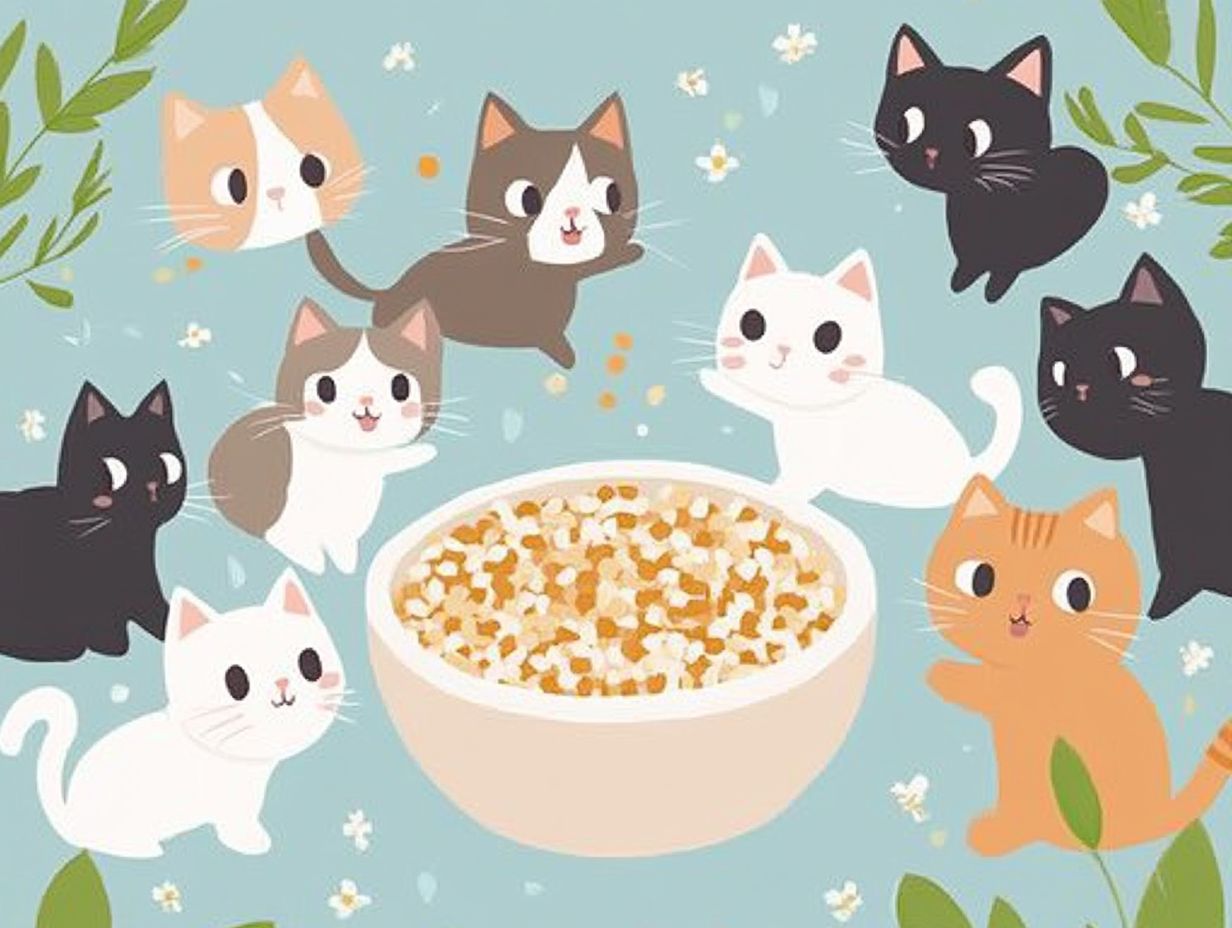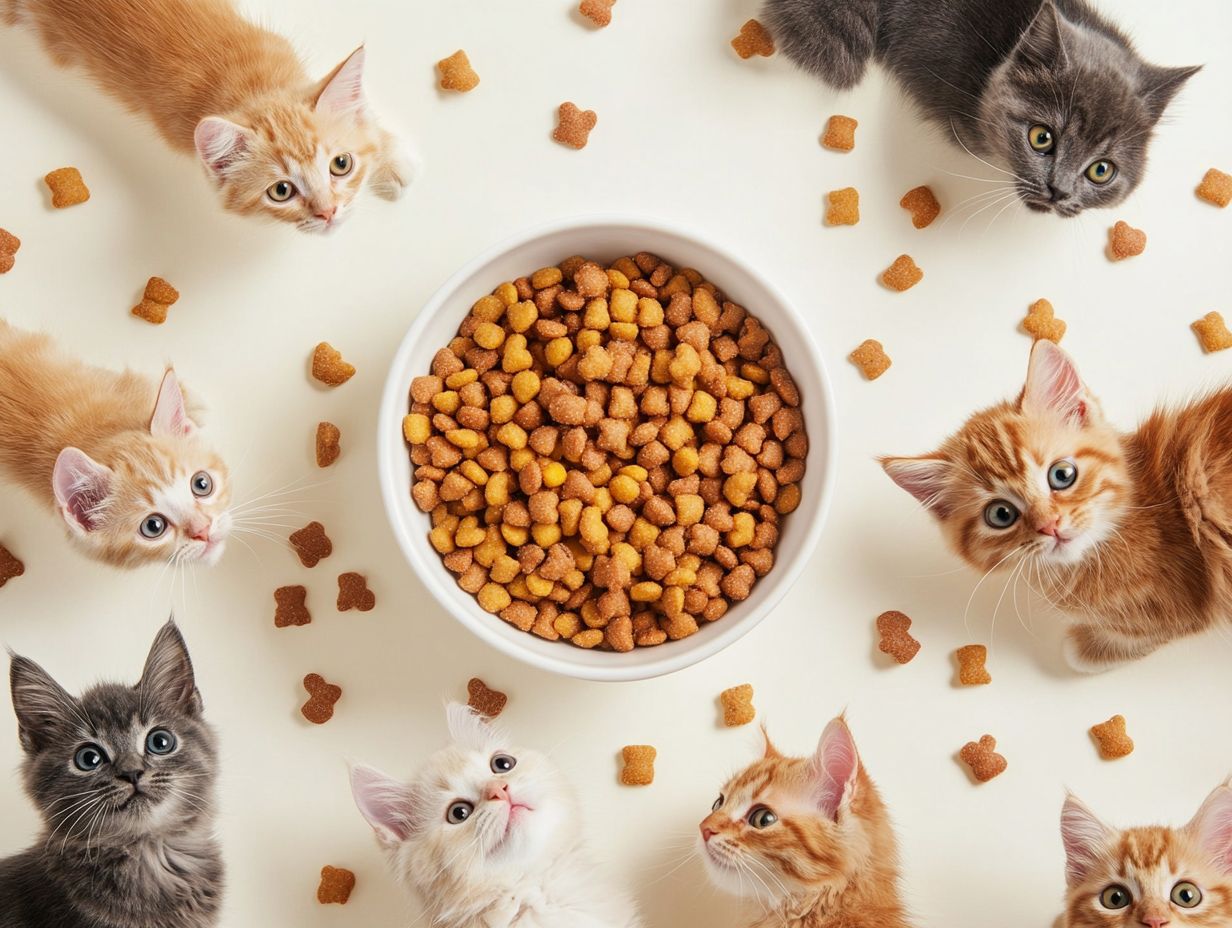When it comes to choosing cat food for your feline friend’s diet, the options can be overwhelming, especially when considering grain-free and grain-inclusive options.
One often overlooked choice is grain-inclusive cat food, which offers a blend of health benefits that can enhance your cat’s overall health and meet their dietary needs.
This article explores what grain-inclusive cat food is, why grains can be important for your cat, and the nutritional profile they provide, including essential vitamins and minerals.
It also discusses the benefits of incorporating grains into your cat’s diet, common grains used such as rice, barley, and oats, and tips for selecting the right food that align with veterinary recommendations.
If you’re curious about how grains can play a positive role in your cat’s nutrition and help with allergy prevention, keep reading!
Key Takeaways:

What is Grain-Inclusive Cat Food?
Grain-inclusive cat food refers to cat food that contains grains such as rice, barley, and oats. This type of food contributes to a balanced diet and is essential for the overall well-being of cats. For more information, check out this article on the 5 Benefits of Grain-Inclusive Cat Food: Why Grains Can Be Good. However, be aware that some cats may have grain allergies; consult your veterinarian for advice on allergy management.
Unlike grain-free cat food, grain-inclusive options include grains that can help prevent some allergies, improve digestive health, and offer other benefits, but they should not be seen as a universal solution. Several brands, including Hill’s Science Diet and Wellness, produce a variety of grain-inclusive cat food products.
Why Do Cats Need Grains?
Cats need a balanced diet to thrive, and grains can significantly contribute to meeting their dietary requirements by offering essential nutrients that support digestive health and overall well-being. However, it is essential to remember that cats are obligate carnivores, and their primary nutrient needs should be met through animal-based proteins.
Although they are naturally carnivorous, cats can benefit from the carbohydrates, vitamins, and minerals present in grains. These elements can help sustain energy levels but should complement, not replace, animal protein sources, particularly in grain-inclusive cat food formulations.
What Nutrients Do Grains Provide for Cats?
Grains such as corn, rice, and oats are rich in carbohydrates, dietary fiber, vitamins, and minerals, enhancing the nutritional value of cat food and helping to meet the overall dietary needs of cats. Be mindful that while grains provide some nutrients, they should not replace animal proteins.
Carbohydrates serve as a potential source of energy in cat food, supporting the daily energy requirements of active cats. Additionally, dietary fiber promotes healthy digestion and reduces the occurrence of gastrointestinal problems. Always ensure that the grains used are properly processed and safe for cats.
Grains are also valuable sources of B vitamins, which aid in energy metabolism, while magnesium supports muscle and nerve function. Overall, grains provide essential nutrients that help supplement a cat’s dietary needs, but introduce new foods gradually to monitor for any adverse reactions.
What Are the Benefits of Grain-Inclusive Cat Food?
Grain-inclusive cat food offers numerous health benefits that can significantly enhance a cat’s quality of life, including digestive health and economic factors. However, there are potential downsides, such as the risk of obesity if not properly balanced with protein and fat content. These benefits include:
- Improved digestive health
- The provision of essential nutrients
- Potential cost savings compared to grain-free options
- Increased dietary variety
- Support for weight management programs
As a result, many veterinarians recommend grain-inclusive diets for cats to address common myths and enhance overall well-being. Regular veterinary consultations are encouraged to tailor dietary needs based on specific health conditions, such as kidney disease or diabetes.
1. Helps with Digestion
One of the key advantages of grain-inclusive cat food is its positive impact on digestive health, as grains provide dietary fibers that help maintain a healthy gut and promote regularity. This is an important consideration for all pet owners when selecting food for their cats.
Grains such as brown rice, oats, and barley play a significant role in supporting a cat’s digestive health. They contain both soluble and insoluble fibers, which assist in the smooth passage of food through the intestines, thereby reducing the likelihood of constipation and diarrhea.
Additionally, proper food storage and handling are crucial to prevent spoilage and contamination of grain-inclusive foods, ensuring they maintain their quality and safety for your cat.
Finally, considering the life stages of cats (kittens, seniors, pregnant or nursing cats) is vital, as their dietary needs might differ with respect to grain inclusion.
Additionally, a fiber-rich diet can help regulate blood sugar levels, but it’s essential to note that cats are obligate carnivores, and their primary protein source should be from animal sources. While fiber can be beneficial in preventing spikes that may lead to obesity, it’s crucial to consult with a veterinarian about the best dietary practices for your cat. Grain-inclusive options can offer a balanced, nutritious diet that aids in the prevention of common gastrointestinal problems, but not all cats may suit these diets depending on their specific dietary restrictions or sensitivities.
2. Provides Essential Nutrients
Grain-inclusive cat food provides essential nutrients, including vitamins and minerals, but it’s important to emphasize that animal-sourced proteins are critical for cats. These animal proteins should not be replaced by grains, which can provide some nutrients but do not offer the same quality as high-quality animal protein. A balanced diet supports a cat’s overall health and significantly enhances the food’s nutritional profile. These nutrients are crucial for various bodily functions, ranging from immune support to skin and coat health.
With a balanced diet, felines benefit from key vitamins such as A, B, and E, which are vital for vision health, energy metabolism, and skin maintenance, respectively. Essential minerals like calcium, phosphorus, and magnesium play important roles in bone health, muscle function, and nerve signaling.
Their synergistic effects contribute to a well-rounded diet for cats that not only meets their energy needs but also promotes longevity and vitality. By selecting grain-inclusive options, pet owners can help ensure their furry companions thrive both physically and mentally, as proper nutrition is a foundational aspect of overall health.
3. Can Be More Affordable

Grain-inclusive cat food is often more affordable than grain-free options, making it a practical choice for cat owners who do not want to compromise their pets’ nutritional needs. However, it’s essential to highlight the balance between cost and nutritional quality, as cheaper options may sometimes compromise essential nutrient profiles. The cost savings associated with these diets are a significant factor in their popularity.
Many pet owners discover that grain-inclusive options have lower price points, especially when comparing similar brands and formulations. Typically, these products utilize grains that are easier to source and less expensive than the higher-quality proteins found in grain-free recipes.
When considering the long-term health benefits of a well-balanced diet, grain-inclusive diets often provide similar nutritional value to premium grain-free products while supporting a cat’s overall health—all at a more budget-friendly price.
4. Offers Variety in Diet
Grain-inclusive cat food offers variety in a cat’s diet, helping to prevent boredom and ensuring that they enjoy their meals, which is crucial for meeting their dietary needs. This diversity can also help prevent food allergies while providing different sources of protein and carbohydrates. However, it’s important to monitor for any adverse reactions and consult a vet for suspected food allergies.
Including grains such as brown rice, oats, and barley enhances the texture of the food and adds essential nutrients that support overall health. These grain-inclusive diets can feature protein sources like chicken, fish, or turkey, delivering a balanced combination of amino acids important for muscle maintenance and energy.
By incorporating both grains and proteins in various ways, these meals provide a comprehensive approach to feline nutrition, promoting healthy digestion and optimal weight management. The variety in texture and flavor keeps cats stimulated during mealtime and ensures they are satisfied with this enhanced eating experience.
5. Can Help with Weight Management
Yes, grain-inclusive cat food is beneficial for weight maintenance, as it is balanced and typically rich in nutrients that help cats feel full. This can reduce the likelihood of obesity, a common issue among domestic cats. Veterinarians often recommend these diets as part of a comprehensive strategy for maintaining a healthy weight in cats. Specific feeding guidelines, including calorie requirements based on life stage, weight, and activity level, should also be considered in line with veterinary recommendations.
Along with providing essential vitamins and minerals, these diets assist in controlling portion sizes and maintaining appropriate calorie content, both of which are crucial for keeping a cat at a healthy weight.
Feeding grain-inclusive options allows owners to ensure that their pets receive a balanced diet that supports a healthy metabolism. Veterinary professionals frequently emphasize the importance of balancing macronutrients—proteins, fats, and carbohydrates—while also managing caloric intake.
This approach is not only effective for weight control but also promotes overall well-being, helping cats remain active and happy, and includes monitoring health through transitioning diets and managing calorie content.
What Are Some Common Grains Used in Cat Food?
Always remember to consult with a veterinarian before making significant dietary changes, especially for cats with health issues like kidney disease or diabetes. Additionally, proper food storage and handling are crucial for preventing spoilage and contamination to maintain safety. Ethical considerations around sourcing ingredients should also be kept in mind, while maintaining the focus on the cat’s nutritional needs.
The grains commonly used in cat food include corn, wheat, rice, oats, and barley. These grains offer a variety of nutritional benefits and are frequently featured as primary ingredients in grain-inclusive cat food formulations. However, due to their obligate carnivore nature, cats primarily require animal-source proteins for optimal health.
1. Corn
Corn is a common grain ingredient found in cat food. It serves as a source of carbohydrates and dietary fiber, both of which are essential for providing energy and supporting digestive health. It’s important to consult veterinary sources like AAFCO for accurate nutritional profiles.
2. Wheat
Wheat is a common ingredient found in cat food, known for its high protein and carbohydrate content, which helps meet the energy needs of active cats. This grain plays a vital role in providing essential nutrients, including vitamins B and E, as well as minerals such as iron and magnesium, all of which are important for maintaining overall health and vitality.
While the nutritional profile of wheat can be beneficial, it is crucial to consider individual dietary needs, especially since some cats may have sensitivities or allergies to grains. For those showing signs of digestive upset or food allergies, consulting a veterinarian is recommended.
Therefore, understanding how wheat fits into a cat’s diet can help pet owners make informed decisions for their furry companions, considering grain-inclusive options that balance the nutritional profile.
3. Rice
Rice is a common ingredient in many grain-inclusive cat food recipes due to its high digestibility. It provides the carbohydrates necessary to meet a cat’s energy requirements, but should not replace essential animal proteins.
As a gently processed carbohydrate, rice is easy for even sensitive cats to digest. It serves as a good source of energy while maintaining a low fat content, which helps cats manage their weight. Pet owners who are mindful of their cats’ diets often incorporate rice to support this goal.
Additionally, rice enhances the flavor of cat food, making it a favorite in feline nutrition.
4. Oats

Oats are high in dietary fiber and beneficial vitamins, making them a healthy ingredient in many grain-containing cat foods. These key features support proper digestive health, promote smoother bowel movements, and reduce the risk of constipation.
The vitamins found in oats, such as B vitamins and vitamin E, contribute to healthy coats and increased energy levels. Additionally, oats can aid in blood sugar regulation, offering a more consistent source of energy.
Overall, oats are a nutritious component of cat food that provide both flavor and essential nutrients for a balanced diet.
5. Barley
Barley is a grain commonly found in cat food, appreciated for its nutritional content and as a source of carbohydrates that support energy levels. Along with providing essential carbohydrates, barley contains important minerals and vitamins that contribute to a cat’s overall health.
Its high fiber content promotes digestive health by aiding regularity and preventing issues such as constipation. This nutrient-dense grain is also recognized for its potential to stabilize blood sugar levels, making it a favorable option for cats, particularly those predisposed to weight gain.
Additionally, including barley in a cat’s diet can enhance palatability, offering a texture that many cats enjoy. Therefore, incorporating this wholesome ingredient can be beneficial for formulating well-rounded and nutritious cat food.
How to Choose the Right Grain-Inclusive Cat Food?
Choosing the best grain-inclusive cat food for your feline companion involves understanding its specific dietary needs and selecting options that offer a well-balanced nutritional profile, ideally endorsed by veterinarians.
Important factors to consider include the quality of ingredients, the sources of protein, and the presence of beneficial grains. Consider brands like Wellness and Hill’s Science Diet that emphasize feline nutrition and align with veterinary recommendations.
What Are Some Alternatives to Grain-Inclusive Cat Food?
Alternative nutrition options for cats that exclude grains—including grain-free cat food, homemade cat food, and raw diets—each come with their own advantages and disadvantages. It’s important to present a balanced view that highlights both the benefits and potential risks of these diets, stressing the importance of consulting with a veterinarian before making dietary changes.
For cats with special dietary needs, such as those with kidney disease or diabetes, it’s critical to consider how these conditions may affect the choice of grains or the absence thereof.
Proper storage and handling of cat food is essential to prevent spoilage. Always check for signs of spoilage, such as unusual odors or changes in texture, particularly in both grain-inclusive and alternative diets.
When selecting cat food, look for products that meet AAFCO standards and consider those with endorsements from veterinary professionals that validate the quality of the food.
Understanding these various dietary options is essential for providing optimal nutrition for felines, with consideration for allergy prevention and digestive health. While some cats may benefit from grain-free diets, they are not universally necessary; it is important to consult with a veterinarian before making dietary changes.
1. Grain-Free Cat Food
Grain-free cat food is specifically designed for cats that require it, often incorporating animal-source proteins. These cat foods exclude certain grains, which some cats may react adversely to, particularly those with allergies.
Grain-free formulas are particularly beneficial for cats with food allergies, especially those sensitive to gluten or suffering from gastrointestinal issues, as the absence of grain facilitates easier and more comfortable digestion. Moreover, grain-free cat food is formulated to meet the nutritional needs of cats, including those with specific allergies.
This is achieved by incorporating high-quality protein sources such as chicken or fish, as well as non-traditional meats like rabbit or venison that may be less likely to trigger allergies. Many options are rich in omega fatty acids, which are beneficial for skin and coat health.
Grain-free cat food offers pet owners a reliable way to implement positive dietary changes for their pets, providing alternatives to grain-inclusive options and supporting health benefits such as improved skin health.
2. Homemade Cat Food
Pros of Homemade Cat Food: Cat owners have the advantage of creating custom meals tailored to their cats’ specific dietary needs. This allows them to balance meals while maintaining control over every ingredient used. Such careful preparation not only supports their cats’ overall health and well-being but can also help reduce or eliminate food allergies or sensitivities that may arise from commercial food products.
Cons of Homemade Cat Food: However, preparing balanced meals requires careful planning and research to ensure that all essential nutritional needs are met. Cats, being obligate carnivores, have specific dietary requirements for certain amino acids, vitamins, and minerals that are typically found in commercial diets. While the ability to choose fresh ingredients is a positive aspect, it is crucial to understand the proper ratios and formulations to prevent deficiencies or excesses, which can negatively impact a cat’s health. These diets must be properly balanced and may require supplementation of essential nutrients that are often lacking in non-commercial diets. These factors represent both the joys and challenges associated with the process of preparing homemade cat food. Always develop these diets in consultation with a veterinarian to avoid nutritional deficiencies.
3. Raw Diet for Cats
A raw diet for cats consists of natural, unprocessed foods that closely resemble what felines would consume in the wild, incorporating high-quality protein sources recommended by veterinarians. This type of diet emphasizes raw meats, organ meats, and even bones, aligning more closely with the nutritional needs of a carnivorous diet.
Proponents of raw diets argue that this feeding method can lead to various potential health benefits for cats, such as improved digestion, increased energy levels, and a shinier coat. However, it is essential for pet owners to ensure a balanced intake of essential nutrients, including vitamins and minerals. Additionally, they should adhere to food safety practices, such as proper hygiene and storage methods, to minimize the risk of bacterial contamination. It is crucial to consult with veterinary professionals before transitioning to a raw diet and to be aware of the risks associated with feeding raw diets without proper knowledge and preparation.
Frequently Asked Questions

What are the benefits of grain-inclusive cat food?
1. Provides essential nutrients: Grains such as rice, corn, barley, and oats are rich in essential nutrients like carbohydrates, vitamins, and minerals. These nutrients are important for a cat’s overall health and well-being, aiding in digestive health and allergy prevention.
2. Better digestion: Grains contain fiber, which can aid in digestion and prevent issues like constipation and diarrhea in cats.
3. Improved energy levels: The carbohydrates found in grains can provide a quick source of energy for cats, helping them stay active and playful.
4. Cost-effective: Grain-inclusive cat food tends to be more affordable than grain-free options, making it a budget-friendly choice for pet owners concerned with economic factors.
5. Potential allergic reactions: Some cats may experience allergic reactions to grains. It’s important to discuss any concerns with a veterinarian.
5. Variety of flavors and textures: Grain-inclusive cat food comes in a variety of flavors and textures, providing a wider range of options for picky eaters, aligning with choosing cat food that suits individual preferences.
Why are grains considered beneficial for cats?
Grains can provide some nutrients, but they should not be prioritized over animal-source proteins, reflecting the obligate carnivore nature of cats. They offer a source of essential nutrients, aid in digestion, provide energy, and are a cost-effective option for pet owners. They also add variety to a cat’s diet, making mealtime more enjoyable, and support veterinary recommendations that emphasize the primary role of animal proteins, with grains serving as supplementary components only if necessary.
What types of grains are typically found in grain-inclusive cat food?
Rice, corn, wheat, oats, and barley are some of the most common grains found in grain-inclusive cat food. While some grains may be easily digestible for cats, they do not provide the essential amino acids that cats require and should not be seen as primary nutrients. These grains can offer a good balance of nutrients, supporting protein source diversity and overall health.
Are there any cats who may benefit from a grain-inclusive diet more than others?
Cats with certain health conditions, such as diabetes or obesity, may benefit from certain diets. However, it is crucial to ensure that any dietary changes follow a veterinarian’s guidance, rather than implying that a grain-inclusive diet is universally beneficial. Consult with veterinarians before making any changes to a cat’s diet to ensure it aligns with feline nutrition standards.
Can a cat be allergic to grains?
Yes, some cats may have allergies to certain grains, just like humans. Symptoms of allergies can overlap with other health issues, so it is essential to consult with a veterinarian before making dietary changes. If your cat experiences symptoms such as skin irritation, gastrointestinal problems, or increased itching after consuming grain-inclusive cat food, it may be allergic to a specific grain. In such cases, it is best to switch to a grain-free diet or consult with a veterinarian for alternative options. Also, be aware of potential toxic ingredients commonly found in grain products, such as mycotoxins, and how to identify safe options.
Do all cats need grain-inclusive food in their diet?
No, not all cats require grain-inclusive food in their diet. Cats are obligate carnivores, meaning they require a diet primarily made up of protein from animal sources. However, grains can provide beneficial nutrients for some cats and can be a part of a well-balanced diet. It is important to monitor a cat’s weight and health status when introducing any new dietary components, including grains, to ensure alignment with the latest feline obesity guidelines.
Proper food storage and handling
Ensure proper food storage and handling practices for both grain-inclusive and grain-free diets to prevent spoilage and contamination risks.